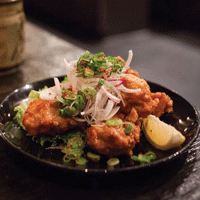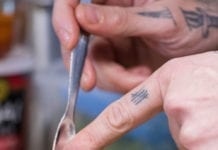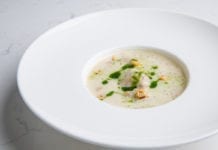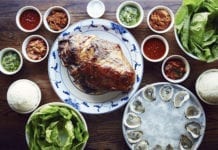When you step into one of Justin Ault’s restaurants, the first thing you’ll notice is his gregarious staff. “Irrashaimase!” the bartenders bellow. For the uninitiated, a loud, but warm Japanese “welcome” may be unnerving, but regulars know it’s one of many quirks that sets this chain
of restaurants apart from the pack.
“Hapa Izakaya is a different experience,” confirms Ault, the brand’s proprietor. “It’s a fun place. It’s almost like being at Cheers,” he says. “We were the first izakaya in Vancouver that didn’t have the same Eric Clapton CD playing over and over.”
Canadian Japanese restos don’t necessarily offer the same sizzle as a Hapa Izakaya, which is styled after an authentic Japanese izakaya — a small tapas-style pub. “What Canadians are used to is a contrived, stereotype designed to be the way people think a Japanese restaurant should look,” says Ault, who, although he’s not a chef, staged in several izakayas in Tokyo before opening Hapa. The overseas experience opened his eyes to the formulaic model the Japanese segment popularized in Canada. “Red lanterns hanging over the blond-wood sushi bar, check; koto music playing in the dining room, check; servers wearing faux kimono, check,” Ault says, rhyming off the clichés.
But, Hapa (Japanese for “leaf” and a term for “a fusion of two cultures”) replaces old school with new cool. Founded by Ault and his wife, Lea, in 2003 it features several brand touchpoints: upbeat contemporary music, slick, modern decor, an open bustling kitchen and sizzling main courses tableside — the Aburi Saba (mackerel sashimi, $9) gets blow-torched seconds before it’s served.
The original 60-seat Robson Street, Vancouver location, which was built with approximately $450,000, was designed as a place where friends could comfortably gather among high-top tables, swank leather-covered banquettes and pendant lighting. “We didn’t want a place friends would feel obligated to visit,” adds the Japanese-Canadian westerner.
The final touch is the brand’s spirited interaction with its customers. “We aim to trigger all five senses and create a unique experience,” says Kevin Banno, director of Operations. “One of the most rewarding things for me is when a first-time guest tells me how amazing everything was and how they didn’t think they liked Japanese food,” he laughs.
So, last September, after five years of planning, the company opened on Toronto’s trendy College Street. Managed by three long-serving B.C. employees of the chain, the first Ontario location is catching on. “We had two sisters and a brother who worked for us for more than 20 years, combined, who were interested in moving to Toronto. If I can’t trust them with the goal and the vision, who the hell can I trust?” says the proprietor, who also recently opened a location in Vancouver’s Coal Harbour.
Ault’s team of capable staff is growing with the company. “We try to hire for the long term,” explains Ault. “It only stands to reason that you’re going to have something that looks nicer and tastes better if someone’s been doing it for three, four, even eight years.” Ault also aims to hire staff who cook authentic Japanese food by tapping into a visa program that allows Canadian and Japanese workers, between the ages of 19 and 30, to swap countries for a year. “This is a huge benefit for us as it provides Japanese kitchen staff to round out our kitchens. I’m proud to say we have about 15 Japanese guys in our kitchens who have either received permanent residence or are in the process of immigrating,” says Ault, explaining that the majority of his culinary teams are comprised of Canadians of Japanese descent, immigrants from Japan or work-permit holders.
Once they’re hired as cooks, Hapa employees are encouraged to exercise creativity using fresh seafood six times a week to create features that complement the daily menu. “Chefs from each location work in unison to develop our dishes. Our chefs facilitate a menu, which changes seasonally with local, fresh ingredients,” says Banno, explaining the menu philosophy behind the chain’s five units.
In fact, Hapa doesn’t have a concept chef who oversees the company’s cooks. “It’s done by committee,” explains Ault. “We have a monthly meeting where we sit down with the chefs and sous chefs — there’s probably 12 of us — and we discuss what’s in season and plan that way.”
And, modern Japanese cuisine is at the root of that discussion. “[The menu] revolves around share plates — groups of three or four people can enjoy eight to 10 dishes and experience something much more interesting than the traditional appetizer/ entrée,” explains Banno. The tapas concept attracts guests who crave variety, with many popular dishes such as Ebi Mayo (spicy tempura prawns; $9) and Chicken Karaage (boneless chicken in soy ginger sauce; $9) as well as a special Omakase Menu ($30), which means “to put yourself in the chef’s hands.”
Hapa Izakaya’s drink program is as distinctive as the brand’s food. “It’s inventive and fun. We offer one of the largest sake menus in Canada, featuring our frozen bamboo take-sakes — our frozen bamboo flask cups — which are very traditional,” Banno explains. “Sapporo, our mainstay, is supported by several local micro-breweries. Cocktails are where we create some fun Japanese-influenced twists on classics as well as present some really different cocktails totally unique to Hapa,” he says.
A cool and sexy ambiance, combined with unique food offerings, a stimulating atmosphere and an extroverted customer-service approach differentiates Hapa from its competitors and wins it kudos from magazines such as Bon Appétit, which placed the brand in its list of top five izakayas in North America in 2011. And, just before press time, Vancouver’s Georgia Straight magazine named the chain Best Izakaya in its reader’s poll.
To top it off, the company gives back to the community. “We support many local charities with donations and gift certificates, and we align ourselves with several large events annually,” says Banno, referencing the Dr. Peter AIDS Foundation in Vancouver and The Powell St. Festival, a large Japanese-Canadian celebration in the West Coast city. The team is also very supportive of Ocean Wise, attending various events hosted by the Vancouver Aquarium each year.
Back at the restaurant, as customers are thrilled by tableside flambéing, and a hostess robustly thanks them with a feisty, “Arigato Gozaimasu,” Ault explains he’ll drive the brand forward with “slow-measured growth.” He believes a careful, deliberate approach to expansion across the country is vital for success, adding it’s important to grow with a team that’s invested in the company, despite ongoing interest from outside the brand. It’s simple: “Hiring a manager who isn’t at least invested emotionally into the company, if not financially, [isn’t] going to be interested in unplugging that toilet the way somebody who’s got a piece of skin in the game would,” jests Ault.
Keep Reading
Hot Concept: Obika Mozzarella Bar
Rising to The Challenge: Discovering New Grains for Your Foodservice Operation
Hot Barbecue Concepts: Food Operators Share Their Philosophies





















